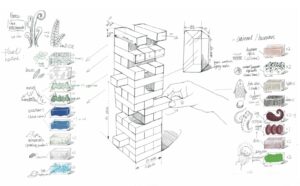Week-9
In this weeks’s lecture, we bring the word ‘ANTHROPOCENE’ again,I learned that anthropocene represents the embodiment of human creativity and technological progress, but it also has negative impacts on ecological balance, including climate change, resource depletion, biodiversity loss, and pollution.
Speaking of the various impacts of human activities on the earth system, It reminds me of Eduardo Kac‘s artworks. He is known for his interdisciplinary experiments, often involving genetic technology and life sciences. One of his famous works is ‘Alba’ the rabbit, a genetically modified white rabbit, a project that sparked discussions about bioethics and the ethics of technology. Overall, his work often deals with the relationship between technology, life and society.
Some of Eduardo Kac’s works can be linked to the concept of Anthropocene.
Anthropocene describes the profound impact of human activities on earth systems, and Kac’s bioart pieces involve biotechnology and genetic engineering, reflecting the impact humans have had on changing life forms.Through his work, Kac often explores human intervention in nature and how technology shapes our relationship with the environment. This echoes Anthropocene’s core idea that human activity is shaping the future of the planet. Therefore, his work can be seen as an artistic response to the impact of human activities in the Anthropocene era.
His ‘Alba’ aims to explore human intervention in genes and changes in life forms. After this lecture, I think it reflects the control and modification of genes by humans in the field of biotechnology in the context of the Anthropocene, and involves whether humans should have the right to modify the genes of other organisms, and whether this the change is sustainable and reversible. Therefore, it can be seen as an artistic expression of the attempt to dominate life in the genetic realm in the Anthropocene, inspiring profound thinking about technology, ethics, and life.

The artwork ‘GENESIS’ by Kac form https://www.ekac.org/
Eduardo Kac introduced the term ‘transgenic art’ in 1998, and in the following three years, he created the ‘transgenic trilogy’.In his work ‘Genesis’, he expressed the domination of human beings over nature, and genes are also a language to some extent, it can be written and modified, and this language is somehow able to manipulate life itself. In my opinion, Katz’s work using genetic art is undoubtedly an irony of what we consider our glorious civilization (or what we done under the Anthropocene). Due to human ignorance, we have destroyed the earth’s ecological environment. This should attract attention and reflection and make more people wake up to consider the concerns of human beings dominating nature and understand nature from a new perspective.
Several years ago, I had a experimental art idea which related to this topic, it is a Jenga game, players can randomly extract and build blocks that symbolize a certain species or a resources in our nature/ecosystems, and player can continue to stack up at the top(to make the whole tower ‘taller’). As each block is continuously drawn and stacked, in the end, whether the whole block will rise or collapse, it will all happen randomly.

This game involves extraction, stacking action and inevitable collapse, a game where there is human subjectivity, the randomness of extraction and the inevitability of collapse, which I will use to suggest the consequences of human beings ‘playing’ with the ecosystem and nature at will.

Reference
(No date) Genesis. Available at: https://www.ekac.org/geninfo.html (Accessed: 17 November 2023).
(No date a) GFP bunny. Available at: https://www.ekac.org/gfpbunny.html (Accessed: 17 November 2023).
Kac, E. (2003) GFP bunny, Leonardo. Available at: https://muse.jhu.edu/article/41743/summary (Accessed: 17 November 2023).
Transgenic art (no date) Encyclopædia Britannica. Available at: https://www.britannica.com/art/transgenic-art (Accessed: 17 November 2023).